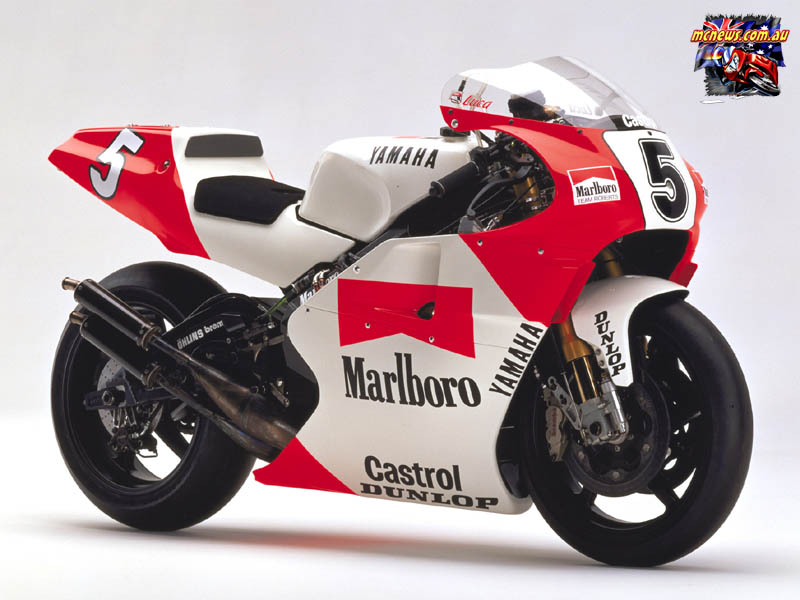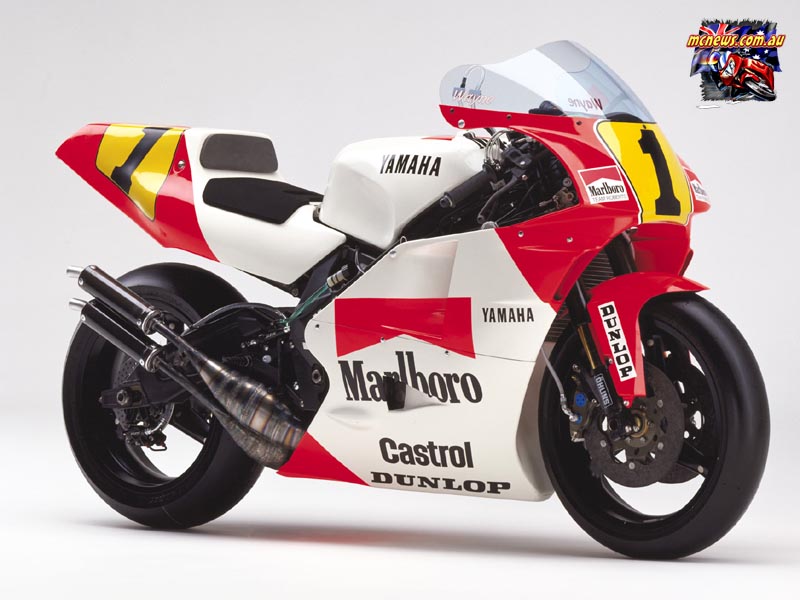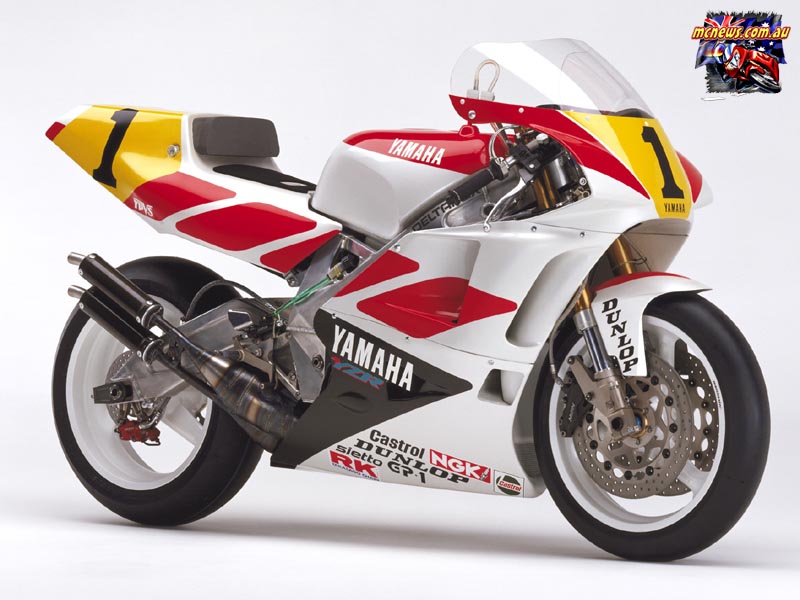Vintage_Mania
1979 Honda CB400T

The Deltabox frame would continue to be a leader on the GP scene while undergoing a number of changes like the structure of the main tube (reinforcing studs added inside the squared cross-section tube), optimizing of alloy types and rigidity balance, etc. The next big turning point in this frame’s design would come in 1993 model YZR500, called the OWF2.
“In an effort to achieve a dramatic improvement in the rigidity of the frame for the OWF2 of ’93, we switched to extruded aluminium parts. Extruded aluminium is made by a process of heating up the aluminium stock to an appropriate temperature and then forcing it through a die to produce tube stock of the desired shape. Because the extrusion process enables more complex shapes than the type of panel stock we had been using and also a higher degree of precision in shape and dimensions, we believed it would be advantageous for improving rigidity.
“When we saw the test results, it in fact gave us much higher rigidity figures than we had ever hoped for. It was a machine with this new frame that Wayne Rainey rode to three consecutive 500cc titles. Studying the motion of the machine in actual racing, however, we observed that there was not a good harmony between the torsion characteristics of the frame itself and the functioning range of the suspension. And, we were not getting good feedback about the handling character at super-high speeds. This was part of the reason the Rainey used an ROC Yamaha frame from the eighth round of that year’s series,” says Mr. Masahiko Nakajima, who was an engineer of OWF2.
Having learned these lessons, the next spec, the OWF9, once again returned to the previous panel-stock frame. This was a period when the focus of Yamaha’s frame design turned to the problem of how to best use the torsion characteristics of an aluminium frame to contribute to handling performance.
The aluminium Deltabox frame technology was eventually fed back to Yamaha’s production supersport models and as is well known today, it went on to have a decisive influence on the world standard for production supersport bikes by all the makers.

In 1990, Wayne Rainey and John Kocinski brought Yamaha double championship title in the 500 and 250 classes. In ’91 Kocinski also moved up to the 500cc class and the YZR500 and this was also the year that the OWD3 spec YZR500 adopted a full-fledged computerised electronic suspension (CES) for the first time. The machine mounting the CES suspension jointly developed with Ohlins would be the one Rainey rode to his second consecutive title in ’91.
The system consisted of (1) a stroke sensor, (2) a control unit and (3) the shock absorber. The stroke sensor was positioned on a parallel axis with the shock absorber to measure the volume and speed of its stroke. In the system, the stroke volume and speed data is sent to the control unit where it is filtered through a pre-programmed map to render an electronic current that is then sent to the shock absorber to drive a solenoid valve that precisely regulates the flow of hydraulic fluid to provide exactly the right amount of cushioning force on both the compression and rebound strokes. The advantage of this system was that it enabled precise setting of the desired damping force in the stroke in accordance with course conditions and/or rider preference simply by rewriting the memory in the control unit’s microcomputer from an external terminal.
“We had begun doing tests with a CES rear suspension from 1989, but ’91 was the first year we used it for the whole GP season. What you could call the “active” suspensions on automobiles were not advantageous for motorcycles because of the complicated parts like the hydraulic fluid pump, the system weight and the space it requires. So, we developed a system that built the damping force control function into the shock absorber itself. By then connecting this to an electronic control unit, the CES system we developed became in effect a passive system that achieved the same effect as an active system. We also provided a fingertip switch that enable the rider to switch between three or so different control maps,” explains Mr. Nakajima.
Although the system was not mounted on later YZR500s, the know-how gained from the development of the CES system would contribute to the later versions of Yamaha’s suspensions. The Monocross suspension that began with considerations about interference with the intake system and chassis material balances would evolve to concerns for rising-rate effect, maturation of the bottom-link format and finally electronic control.
With Wayne Rainey’s successive titles in 1990 and ’91, Yamaha won both the GP500 manufacturer and rider titles two consecutive years. At the same time, however, the number of machines competing in 500cc Grands Prix was decreasing steadily, and some were even beginning to worry about whether or not the championships would survive.
In answer to this need to stimulate the GP race scene, Yamaha announced in September of ’91 that it would provide its YZR500 engine to any of the prominent constructors in Europe at the time that wished to use it. Actual sales began in ’92 was a part of Yamaha’s efforts to promote the sport of motorcycle racing. In fact, Europe had a long tradition of GP teams that used engines by the makers mounted on frames built by the constructors to produce competition machines. It was Yamaha’s belief that the racing scene would be stimulated by the presence of new teams using machines constructed in Europe according to this tradition.

The release of technology in the form of these engine sales brought a big change to GP racing. A full two-thirds of the machines on the starting grid for the 500cc class on March 29 in the ’92 GP series’ opening round at Suzuka were powered by the Yamaha YZR500 engine and the number of machines was larger. Riding the ’92 spec OWEO (YZR500) were Rainey, John Kocinski, Juan Garriga, Miguel Duhamel, Niall Mackenzie, Kevin Magee and Norihiko Fujiwara, while Randy Mamola and Eddie Laycock competed on 1990 model OWC1s fitted with ’92-spec motors. In addition, 14 other riders competed on Harris Yamaha and ROC Yamaha machines.
“We considered working to stimulate the 500cc class to a mission just as important to us as winning the title. The European constructor machines from Harris and ROC mounting Yamaha engines gave many more riders a chance to compete in the GP and made the races more exciting and competitive,” says Mr. Shyuji Sakurada who was a chief of this project. Along with the challenge of winning the GP, Yamaha was equally eager to promote the sport itself.
During this period, Yamaha released vital machine technologies to ROC and Harris. Perhaps never before in the history of the GP had a factory provided constructors with design blueprints and full instructions on the full details of maintenance and setting methods like this. And, the base machine to which this information applied was the OWC1 that Rainey had won the title with in 1990.
Using made-in-Europe aluminium stock, the constructors built their own brand bikes with chassis equivalent to the YZR500 (OWC1) to enter in the GP. Between 1992 and ’94 ROC Yamaha and Harris Yamaha placed fifth and sixth in the constructors championship ranking. It was not only due to the competitiveness of their Yamaha engines but also a measure of the all-round qualities of the machines, ranging from set-up to serviceability. The fact that such competitive machines could be built without special aluminium alloys but just commercially available aluminium stock was also a statement about the basic soundness of the Yamaha chassis designs. Beyond the successive championship titles won by Yamaha in these years (1990 to 1992 by Rainey), we also see an important aspect of the Yamaha corporate philosophy in its willingness to release technical information for the sake of the sport.




